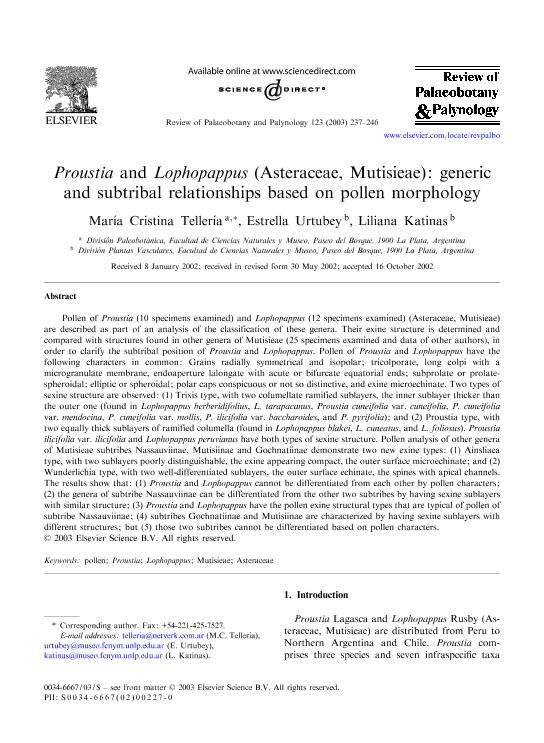Artículo
Proustia and Lophopappus (Asteraceae, Mutisieae): Generic and subtribal relationships based on pollen morphology
Fecha de publicación:
03/2003
Editorial:
Elsevier Science
Revista:
Review of Palaeobotany and Palynology
ISSN:
0034-6667
Idioma:
Inglés
Tipo de recurso:
Artículo publicado
Clasificación temática:
Resumen
Pollen of Proustia (10 specimens examined) and Lophopappus (12 specimens examined) (Asteraceae, Mutisieae) are described as part of an analysis of the classification of these genera. Their exine structure is determined and compared with structures found in other genera of Mutisieae (25 specimens examined and data of other authors), in order to clarify the subtribal position of Proustia and Lophopappus. Pollen of Proustia and Lophopappus have the following characters in common: Grains radially symmetrical and isopolar; tricolporate, long colpi with a microgranulate membrane, endoaperture lalongate with acute or bifurcate equatorial ends; subprolate or prolate-spheroidal; elliptic or spheroidal; polar caps conspicuous or not so distinctive, and exine microechinate. Two types of sexine structure are observed: (1) Trixis type, with two columellate ramified sublayers, the inner sublayer thicker than the outer one (found in Lophopappus berberidifolius, L. tarapacanus, Proustia cuneifolia var. cuneifolia, P. cuneifolia var. mendocina, P. cuneifolia var. mollis, P. ilicifolia var. baccharoides, and P. pyrifolia); and (2) Proustia type, with two equally thick sublayers of ramified columella (found in Lophopappus blakei, L. cuneatus, and L. foliosus). Proustia ilicifolia var. ilicifolia and Lophopappus peruvianus have both types of sexine structure. Pollen analysis of other genera of Mutisieae subtribes Nassauviinae, Mutisiinae and Gochnatiinae demonstrate two new exine types: (1) Ainsliaea type, with two sublayers poorly distinguishable, the exine appearing compact, the outer surface microechinate; and (2) Wunderlichia type, with two well-differentiated sublayers, the outer surface echinate, the spines with apical channels. The results show that: (1) Proustia and Lophopappus cannot be differentiated from each other by pollen characters; (2) the genera of subtribe Nassauviinae can be differentiated from the other two subtribes by having sexine sublayers with similar structure; (3) Proustia and Lophopappus have the pollen exine structural types that are typical of pollen of subtribe Nassauviinae; (4) subtribes Gochnatiinae and Mutisiinae are characterized by having sexine sublayers with different structures; but (5) those two subtribes cannot be differentiated based on pollen characters.
Palabras clave:
ASTERACEAE
,
LOPHOPAPPUS
,
MUTISIEAE
,
POLLEN
,
PROUSTIA
Archivos asociados
Licencia
Identificadores
Colecciones
Articulos(CCT - LA PLATA)
Articulos de CTRO.CIENTIFICO TECNOL.CONICET - LA PLATA
Articulos de CTRO.CIENTIFICO TECNOL.CONICET - LA PLATA
Citación
Tellería, María Cristina; Urtubey, Estrella; Katinas, Liliana; Proustia and Lophopappus (Asteraceae, Mutisieae): Generic and subtribal relationships based on pollen morphology; Elsevier Science; Review of Palaeobotany and Palynology; 123; 3-4; 3-2003; 237-246
Compartir
Altmétricas




